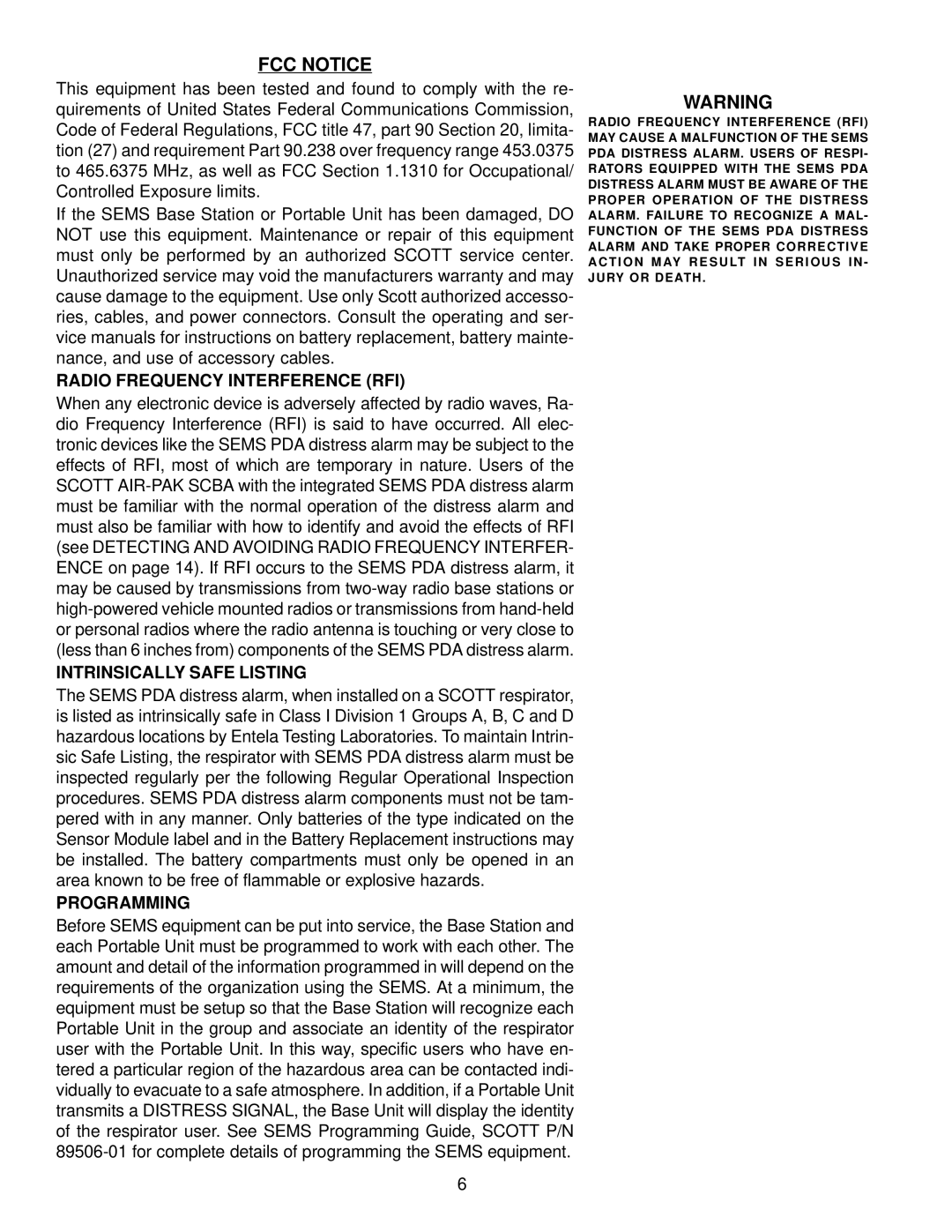FCC NOTICE
This equipment has been tested and found to comply with the re- quirements of United States Federal Communications Commission, Code of Federal Regulations, FCC title 47, part 90 Section 20, limita- tion (27) and requirement Part 90.238 over frequency range 453.0375 to 465.6375 MHz, as well as FCC Section 1.1310 for Occupational/ Controlled Exposure limits.
If the SEMS Base Station or Portable Unit has been damaged, DO NOT use this equipment. Maintenance or repair of this equipment must only be performed by an authorized SCOTT service center. Unauthorized service may void the manufacturers warranty and may cause damage to the equipment. Use only Scott authorized accesso- ries, cables, and power connectors. Consult the operating and ser- vice manuals for instructions on battery replacement, battery mainte- nance, and use of accessory cables.
RADIO FREQUENCY INTERFERENCE (RFI)
When any electronic device is adversely affected by radio waves, Ra- dio Frequency Interference (RFI) is said to have occurred. All elec- tronic devices like the SEMS PDA distress alarm may be subject to the effects of RFI, most of which are temporary in nature. Users of the SCOTT
INTRINSICALLY SAFE LISTING
The SEMS PDA distress alarm, when installed on a SCOTT respirator, is listed as intrinsically safe in Class I Division 1 Groups A, B, C and D hazardous locations by Entela Testing Laboratories. To maintain Intrin- sic Safe Listing, the respirator with SEMS PDA distress alarm must be inspected regularly per the following Regular Operational Inspection procedures. SEMS PDA distress alarm components must not be tam- pered with in any manner. Only batteries of the type indicated on the Sensor Module label and in the Battery Replacement instructions may be installed. The battery compartments must only be opened in an area known to be free of flammable or explosive hazards.
PROGRAMMING
Before SEMS equipment can be put into service, the Base Station and each Portable Unit must be programmed to work with each other. The amount and detail of the information programmed in will depend on the requirements of the organization using the SEMS. At a minimum, the equipment must be setup so that the Base Station will recognize each Portable Unit in the group and associate an identity of the respirator user with the Portable Unit. In this way, specific users who have en- tered a particular region of the hazardous area can be contacted indi- vidually to evacuate to a safe atmosphere. In addition, if a Portable Unit transmits a DISTRESS SIGNAL, the Base Unit will display the identity of the respirator user. See SEMS Programming Guide, SCOTT P/N
WARNING
RADIO FREQUENCY INTERFERENCE (RFI) MAY CAUSE A MALFUNCTION OF THE SEMS PDA DISTRESS ALARM. USERS OF RESPI- RATORS EQUIPPED WITH THE SEMS PDA DISTRESS ALARM MUST BE AWARE OF THE PROPER OPERATION OF THE DISTRESS ALARM. FAILURE TO RECOGNIZE A MAL- FUNCTION OF THE SEMS PDA DISTRESS ALARM AND TAKE PROPER CORRECTIVE A C T I O N M AY R E S U LT I N S E R I O U S I N - JURY OR DEATH .
6
